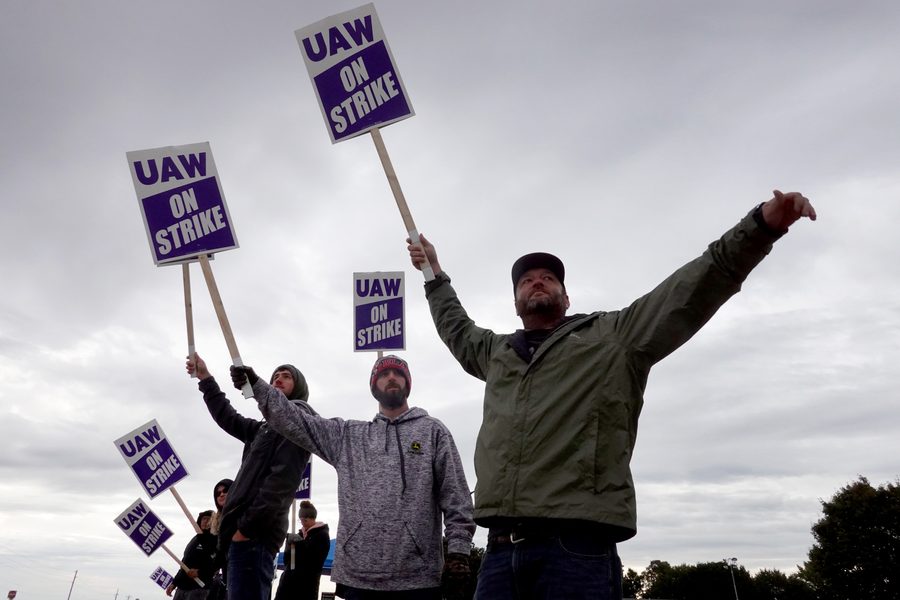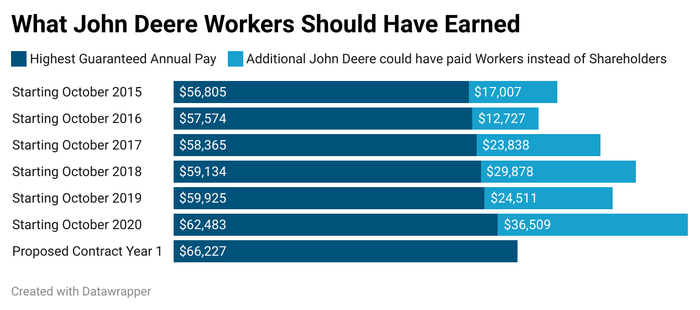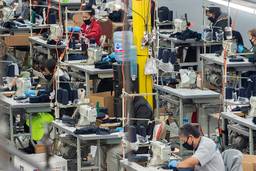For the $10 Billion It Gave Shareholders, John Deere Could Have Given Each Worker $142,000
Workers made a fortune for shareholders over the last six-year contract. They should demand that they get paid their true worth before shareholders get a penny.
Colleen Boyle

On October 14, 10,000 John Deere workers in Iowa, Illinois, Kansas, Colorado and Georgia went on strike after overwhelmingly rejecting the new contract negotiated between John Deere and their union, the United Auto Workers (UAW). “When you factor in the pandemic, being deemed essential workers, and in our case, having a company turning a record profit, the CEO giving himself a 160 percent raise, and giving a 17 percent dividend raise, we kinda feel like we’re left to kick rocks,” a striking UAW member and worker at Iowa’s Davenport Works (who requested anonymity) recently told Labor Notes.
John Deere’s profits and CEO pay are, indeed, worth pointing out. But it also is worth taking a look at where John Deere has spent the bulk of its profits since the last contract with the UAW was signed in 2015.
From fiscal year 2016 through the first nine months of fiscal year 2021, John Deere earned more than $16 billion in profits. The company spent roughly $5 billion on dividends and $4.95 billion on share repurchases; nearly $10 billion in total was given to shareholders during the six years of the previous contract.
What does this mean for the workers at John Deere? With the money John Deere gave to shareholders, it could have paid each of its 69,600 worldwide employees an additional $142,000 over the past six years.
It’s difficult to come up with a typical yearly salary for a UAW member at John Deere because of multiple pay rates (12 pay levels, each with six steps), and because some workers are subject to Deere’s “continuous improvement pay plan” with lower hourly base pay but the potential for productivity-based bonuses. The contract that striking John Deere workers rejected stipulated, in the first year, hourly wage rates that range from $20.01 to $31.84 depending on position and seniority. For the sake of argument, if we assume someone is paid for 2,080 hours during a full year (8 hours per day, 5 days per week, for 52 weeks), the highest guaranteed annual salary under the proposed contract was $66,227, up from $62,483 in the final year of the last contract.
Over the course of the last six-year contract, workers with the highest hourly wage received cumulative wage increases of $13,488. John Deere could have increased workers’ wages 10 times that amount instead of giving handouts to shareholders. And the proposed contract would have, similarly, shorted workers, as the following graphic shows.

Since the early 1980s, workers have received a shrinking share of the wealth they create. You may have seen some version of the Economic Policy Institute’s graph showing that private sector wage growth matched productivity growth between the end of World War II and around 1980. Since then, productivity has risen more than three times as much as workers’ wages.
The widening gap between worker pay and productivity means that the wealth created by workers is going to the richest 10 percent of Americans who own 84 percent of the value of the U.S. stock markets. While executive compensation has also skyrocketed during the past 40 years, CEO pay is a drop in the bucket compared to the money companies are giving to shareholders in the form of share repurchases and dividends. Not coincidentally, the beginning of the productivity-pay gap happens to coincide with the 1982 issuance of a new rule by the Securities and Exchange Commission that allowed publicly-traded companies to repurchase shares.
While there are some regulatory actions the federal government can take to limit these public company payments to shareholders — outlawing share repurchases again or raising taxes on capital gains and dividends, for example — truly reversing the upward distribution of wealth from workers to shareholders will only happen through worker militancy like the John Deere strike.
Workers have an opportunity to demand that they get paid their true worth before shareholders get a penny. Deere has taken $36,000 created by each worldwide employee just this year and put it into shareholders’ bank accounts. UAW members should keep their hands in their pockets and stay on strike until they get a significant chunk of that money back.
| Year | Dividends | Share Repurchases | Total to Shareholders | Total Per Current Worldwide Employee |
| 2016 | $761 million | $205 million | $966 million | $13,879 |
| 2017 | $764 million | $6 million | $770 million | $11,063 |
| 2018 | $806 million | $958 million | $1,764 million | $25,344 |
| 2019 | $943 million | $1,253 million | $2,196 million | $31,551 |
| 2020 | $956 million | $750 million | $1,706 million | $24,511 |
| 2021 to Aug 1 | $761 million | $1,780 million | $2,541 million | $36,508 |
The widening gap between worker pay and productivity means that the wealth created by workers is going to the richest 10 percent of Americans who own 84 percent of the value of the U.S. stock markets. While executive compensation has also skyrocketed during the past 40 years, CEO pay is a drop in the bucket compared to the money companies are giving to shareholders in the form of share repurchases and dividends. Not coincidentally, the beginning of the productivity-pay gap happens to coincide with the 1982 issuance of a new rule by the Securities and Exchange Commission that allowed publicly-traded companies to repurchase shares.
While there are some regulatory actions the federal government can take to limit these public company payments to shareholders — outlawing share repurchases again or raising taxes on capital gains and dividends, for example — truly reversing the upward distribution of wealth from workers to shareholders will only happen through worker militancy like the John Deere strike.
Workers have an opportunity to demand that they get paid their true worth before shareholders get a penny. Deere has taken $36,000 created by each worldwide employee just this year and put it into shareholders’ bank accounts. UAW members should keep their hands in their pockets and stay on strike until they get a significant chunk of that money back.




